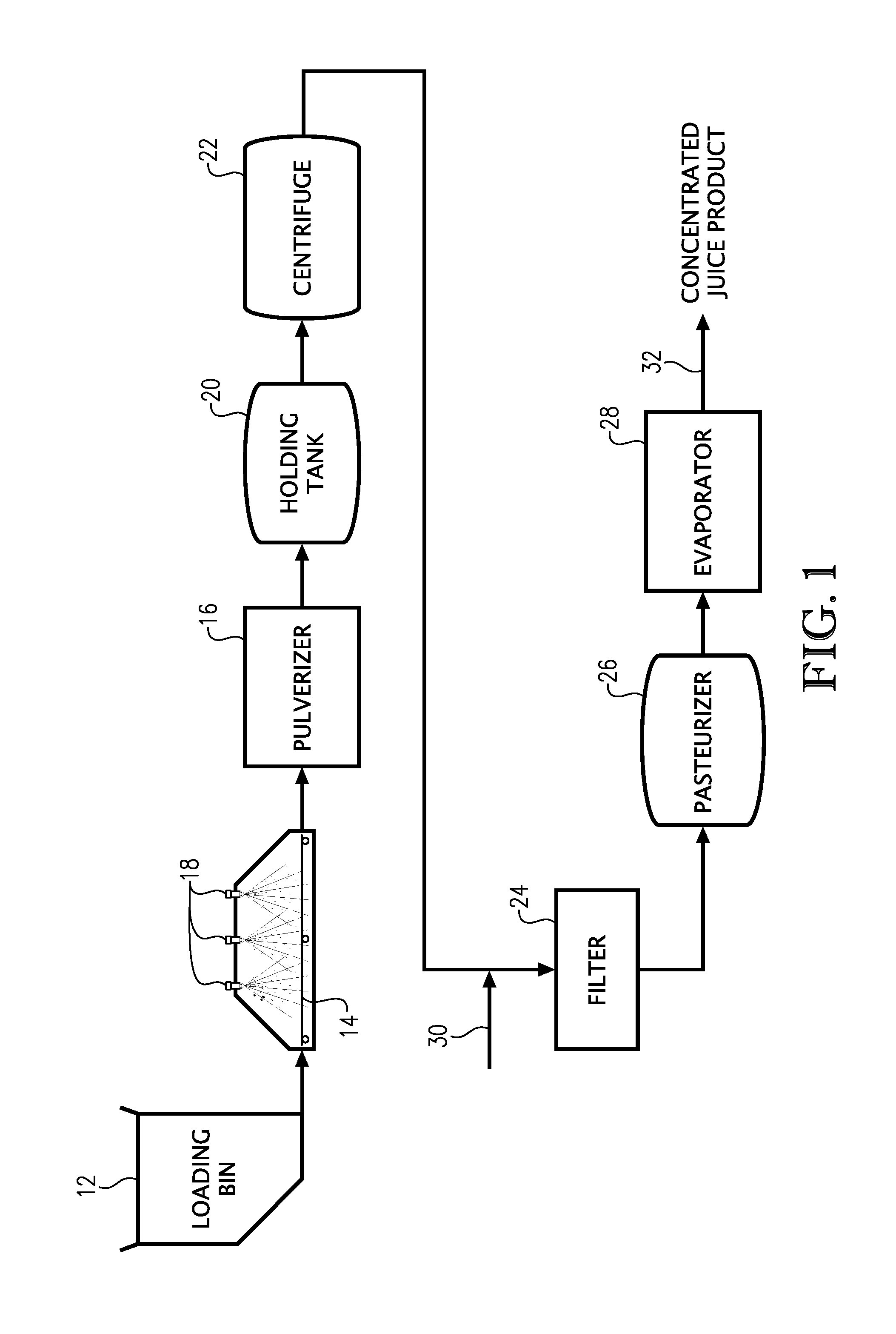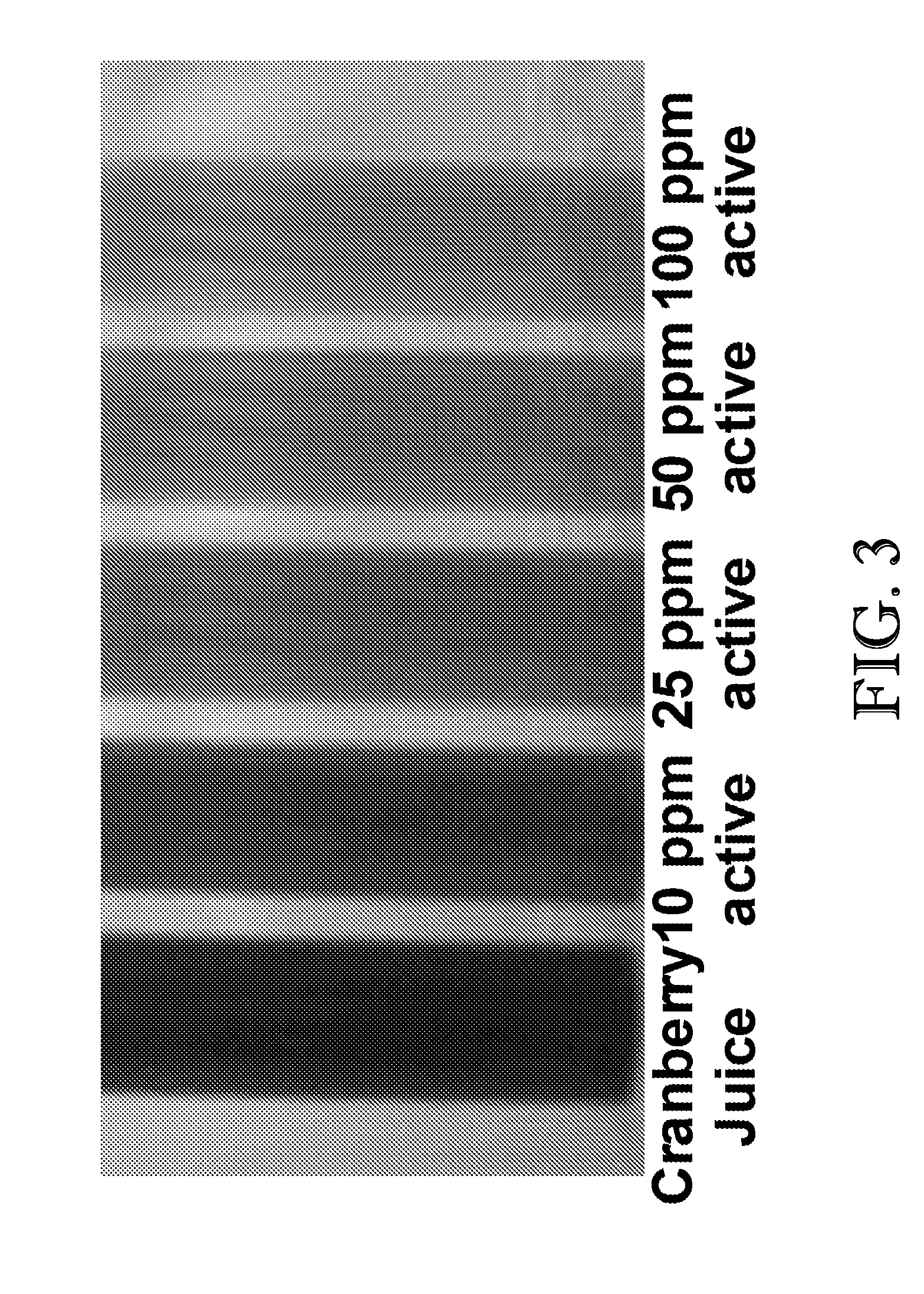Process for controlling microorganisms in beverage products
a technology for beverage products and microorganisms, applied in the field of process for controlling microorganisms in beverage products, can solve the problems of increasing the number of problems, affecting the taste and smell of the final product, and not 100% effective against all microorganisms, and achieve the effect of adversely affecting the taste or color of the final produ
- Summary
- Abstract
- Description
- Claims
- Application Information
AI Technical Summary
Benefits of technology
Problems solved by technology
Method used
Image
Examples
example 1
[0033]In this experiment, several juices were dosed with peracetic acid (PAA) (peroxyacetic acid 5.6%, hydrogen peroxide 26.5%) and kept at a controlled temperature (22° C. or 90° C.) for a given period of time to determine how the PAA would degrade over time. At the end of the given time period, the level of PAA remaining in the juice was measured by titration with 0.1N sodium thiosulfate. The results are listed in Table 1. It can be seen that the PAA decomposed quite rapidly in the various juices, particularly when exposed to elevated temperatures.
TABLE 1Juice1BrixPAA dosedTempTimePAA readapple11.4100 ppm22° C.60 min19.6 ppmcarrot8.8100 ppm22° C.60 min3.92 ppmapple*11.4100 ppm90° C.10 min15.7 ppmcarrot*8.8100 ppm90° C.10 min2.94 ppmapple*11.4 20 ppm90° C.10 mincarrot*8.8 20 ppm90° C.10 min*followed by 5 min in ice to a final temperature of 20° C.1Commercially available, organic pasteurized ready-to-drink juice.
example 2
[0034]In this experiment, apple juice and carrot juice were exposed to pure and stable chlorine dioxide (CDG Solution 3000™, CDG Environmental, LLC) in order to determine their respective chlorine dioxide demands, as determined by HACH DPD Method for Chlorine dioxide (Method #10126). The juice samples were exposed to the chlorine dioxide under room temperature conditions (22° C.), and then the residual concentrations determined 10 minutes after exposure. The results of this experiment are shown in Table 2. It can be seen that the chlorine dioxide demands were relatively high.
TABLE 2Exposed ConcentrationRead ConcentrationDemandJuice1Brix(ppm)(ppm)(ppm)Apple11.45>4.95Apple11.4100.689.32Apple11.4250.724.3Apple11.4602.257.8Carrot8.85>4.95Carrot8.810>9.95Carrot8.825>24.97Carrot8.8600.1359.871Commercially available, organic pasteurized ready-to-drink juice.
example 3
[0035]In this experiment, the antimicrobial efficacy of PAA in organic apple and carrot juice was measured by challenging the juices with 1×107 CFU / ml of Alicyclobacillus acidoterrestris, a spore-forming thermophile commonly present in juice operations. Immediately following bacterial challenge, the juice was dosed with different concentrations of PAA and incubated at room temperature (22° C.) for 10 minutes without agitation. After the subscribed contact time, the PAA was neutralized with D / E broth and a viability count for each of the juices was performed using the most probable number technique (MPN). Overall, a PAA dose as low as 0.35 ppm was able to produce a substantial loss in cell viability. As can be seen in FIG. 4, the PAA-treated samples all exhibited greater than a 4-log reduction in the bacteria.
PUM
| Property | Measurement | Unit |
|---|---|---|
| temperature | aaaaa | aaaaa |
| temperature | aaaaa | aaaaa |
| temperature | aaaaa | aaaaa |
Abstract
Description
Claims
Application Information
 Login to View More
Login to View More - R&D
- Intellectual Property
- Life Sciences
- Materials
- Tech Scout
- Unparalleled Data Quality
- Higher Quality Content
- 60% Fewer Hallucinations
Browse by: Latest US Patents, China's latest patents, Technical Efficacy Thesaurus, Application Domain, Technology Topic, Popular Technical Reports.
© 2025 PatSnap. All rights reserved.Legal|Privacy policy|Modern Slavery Act Transparency Statement|Sitemap|About US| Contact US: help@patsnap.com



